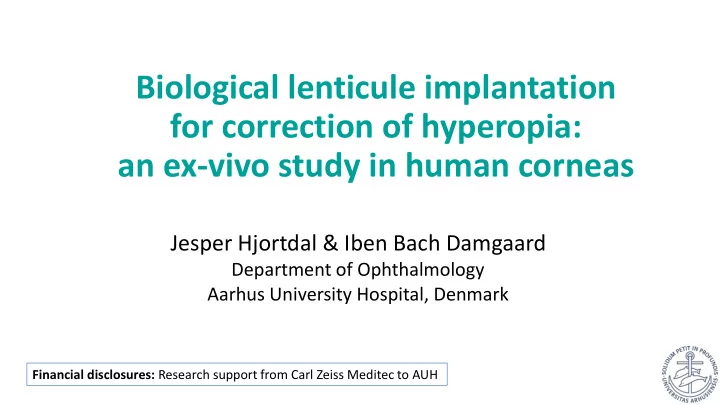

Biological lenticule implantation for correction of hyperopia: an ex-vivo study in human corneas Jesper Hjortdal & Iben Bach Damgaard Department of Ophthalmology Aarhus University Hospital, Denmark Financial disclosures: Research support from Carl Zeiss Meditec to AUH
Biological Lenticule Implantation - Possibilities • Precise cutting of stromal lenticules is today possible with the VISUMAX femto-second laser and lenticule implantation may enable: • Correction of Hyperopia • Supplementing corneal volume after keratitis • Treatment of keratoconus
Purpose – In vitro study related to hyperopia • To evaluate changes in corneal tomography after stromal lenticule implantation ex vivo, with respect to • the dependency of the lenticule thickness and implantation depth on the corneal curvature • the postoperative biomechanical strength at increased chamber pressure.
Materials & Methods • 56 human donor corneas unsuitable for patient treatment: 28 for lenticule harvesting and 28 for lenticule implantation • Four groups of seven mounted donor corneas with a combination of one of two implantation depths (110 and 160 μ m) and one of two thicknesses of the implanted lenticules (95 and 150 μ m). • Measurements at 15 and 40 mmHg chamber pressure • Controlled (normo-) hydration of the cornea using 8% Dextran- containing organ-culture medium
Materials & Methods • Pentacam HR • Radius of curvature of front- and back-surface • Total Corneal Refractive Power (TCPR) • Measurements before and after lenticule implantation • Measurements at 15 and 40 mmHg
Results – Radius of Curvature Steepening But similar for 4 & 8 D Most @ 110 µm depth Flatter Most for 8 D lenticule Similar @ 110 & 160 µm depth
Results – Total Corneal Refractive Power • Change in refractive power was less than the power of implanted the lenticules • Change in refractive power was less when lenticules were implanted at 160 µm depth • Change in refractive power was highest at high pressure levels
Conclusions • The current study showed that the achieved correction was generally lower than the power of the implanted lenticule. • Higher powered lenticules tended to induce more posterior flattening than anterior curvature steepening. • Increased chamber pressure after implantation caused significant steepening of the anterior surface possibly due to weakening of the corneal tissue, and consequently higher TCRP values. • However, further studies are needed to confirm these findings.
Remember • Implantation of corneal lenticules is a tissue transplantation • In the EU, you have to comply with DIRECTIVE 2004/23/EC OF THE EUROPEAN PARLIAMENT AND OF THE COUNCIL of 31 March 2004 on setting standards of quality and safety for the donation, procurement, testing, processing, preservation, storage and distribution of human tissues and cells • In practice only lenticules harvested from corneal donor tissue under the responsibility of a corneal bank can be used clinically
Recommend
More recommend